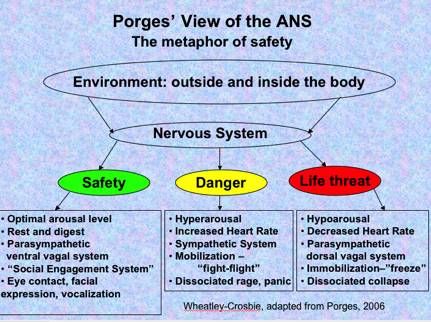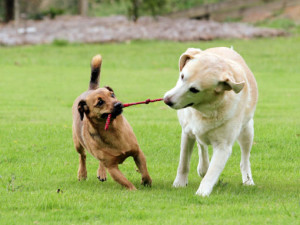Neuroscientist Dr. Stephen Porges explained in my Sept.19 blog that when a survival threat pushes humans back into the ancient reptilian mechanism of freeze, that’s how trauma happens. The autonomic nervous system (ANS in diagram below) just does this automatically; we don’t have a say; it’s not cognitive. Porges says that for humans to be out of trauma, mammalian attachment must happen.

For that, Dr. Porges says, we need what he calls “the social engagement system… in which we listen to intonation in voice and use facial engagement. When a person has vocal intonation, an expressive face and eyes open when we talk to them, this expressive individual is also contracting middle ear muscles that facilitate the extraction of human voice from background sounds,” he says. [FN]
“When people are smiling and looking at us, they are better able to pull out human voice from back ground sounds.
“We also use ingestive behaviors; the baby nurses. Adults use the same systems. We go to lunch or we go for a drink, as a way of socializing. Ingestive behaviors use the same neural mechanisms we use for social behavior. We use ingestive behaviors to calm and to develop social engagement. And when that is done, the physical distance between people can be modulated and we can come close…
“Safety modulates our ability to develop secure attachments. Whether an individual feels safe with people during early development might modulate individual differences in vulnerability to trauma.”
Dr. Porges’ 1994 “Polyvagal Theory” says the autonomic nervous system is not a balance of two circuits, but instead “a hierarchical system” of three circuits, “in which newer circuits inhibit older circuits. And when we get challenged, those systems degrade to older and older circuits, in an attempt to survive.” We mammals start out trying to use our “social engagement system” to look at each other and resolve things warmly; that’s our first, myelinated vagus parasympathtic circuit.
If that fails, we devolve into more primitive fight/flight animals, where our sympathetic circuits take over and juice up our adrenalin.
And if that fails, our ancient reptilian unmyelinated vagus circuit takes over and knocks us out into immobilization, called dissociation in humans.
Play and Mammalian Attachment
 One way to get people back out of dissociation, aka freeze — aka trauma — says Porges, is to surround them with friendly mammals, and stimulate their mammalian social engagement systems to come back on line. He gives the fascinating example of play.
One way to get people back out of dissociation, aka freeze — aka trauma — says Porges, is to surround them with friendly mammals, and stimulate their mammalian social engagement systems to come back on line. He gives the fascinating example of play.
“Real play, is not playing with a ‘Game Boy’ or computer; it is not solitary,” Porges says. “Play requires social interaction using face-to-face. ” Notice how the two dogs above are looking each other in the eye.
“Play requires an ability to mobilize with the sympathetic nervous system and then to down-regulate the sympathetic excitation, using face-to-face social interaction and the social engagement system. I have two little dogs; they chase each other, and nip. Then one will turn around to look at the other, a face-to-face interaction to ensure that biting was play and not aggression.”
In play, he says, we practice using our fight/flight systems properly – but we also practice to “diffuse them with social engagement. So play requires face-to-face interactions. We see this in virtually all mammals.”
“I use video clips of Dr. J. and Larry Bird, a clip in which they are friends.doing an advertisement for sneakers,” Porges notes. “Then I show them playing basketball, bumping and hitting each other. Dr. J. hits Larry Bird in the face, knocks him to the ground and walks away. By walking away, he didn’t diffuse the mobilization behaviors from fight/flight. So Bird goes after him and they have a fight.
“When we play, we mobilize physiological state changes that support fight/flight behaviors, but then we down-regulate defensive reactions by looking at each other – so that we learn to repair If we hit each other by mistake, we say ‘I’m sorry.’
“Other forms of adult play have similar features – such as dancing. Most forms of team sports involve face-to-face interactions that include communication via eye contact.
“Play is actually a neural exercise of using the social engagement system, a uniquely mammalian system, to regulate our fight/flight behaviors, to be able to down-regulate this older defensive system. Note that individuals with a variety of clinical pathologies often have difficulty playing.”
Heal Trauma by Acceptance – Not Stigma
 So when we don’t receive attachment — which allows us to use our mammalian myelinated vagus parasympathetic — then, we feel endangered. Then our bodies are triggered to devolve into our second, more primitive fight/flight response (mobilizing our sympathetic system).
So when we don’t receive attachment — which allows us to use our mammalian myelinated vagus parasympathetic — then, we feel endangered. Then our bodies are triggered to devolve into our second, more primitive fight/flight response (mobilizing our sympathetic system).
Further, if we are overwhelmed and fight/flight doesn’t get us to safety, our neurological system hijacks us and forces us back into our third, most primitive response: freeze, aka immobilization or dissociation (using the reptilian unmyelinated vagal system).
Almost all trauma occurs when we are overpowered just like that, by dangerous environments or people.
Polyvagal Theory also shows that our nervous system just does these things – trauma is simply not a voluntary decision. “Outside the realm of our conscious awareness, our nervous system is continuously evaluating risk in the environment,” and shoving us into bodily actions that are just not subject to thought, Porges shows.
So Dr. Porges is asking doctors and therapists to realize that tramatized people can best be healed if everyone accepts and respects what their bodies have done – instead of stigmatizing them for it.
“Try something different with clients,” Porges tells clinicians. “Tell clients who were traumatized that they should celebrate their body’s responses, even if the profound physiological and behavioral states they experienced in past, are now limiting their ability to function in current social situations. Those bodily responses enable them to survive under the trauma, often as children. It reduced some of the injury. If they were oppositional during an aggressive traumatic event such as rape, they could have been killed.
“So tell them to celebrate how their body responded — instead of making them feel guilty that their body is failing them when they want to be social –and see what happens.
“Therapies often convey to the client that their body is not behaving adequately. The clients are told they need to be different. They need to change. That kind of therapy in itself is too judging of these individuals. And once we are evaluated, we are in defensive states. We are not in safe states.
“Mindfulness requires feeling safe because if we don’t feel safe, we are, in a sense, neuro-physiologically evaluative of our setting which means we can’t be safe, and we can’t engage. We can’t recruit the wonderful neural circuits that enable us to express the wonderful aspects of being human. So if we are able to create safe environments,” starting with clinicians who make us feel respected and safe, “we have access to neural circuits that enable us to be social, to learn, and to feel good.”
Once the professionals accept reality, next traumatees can start to respect themselves, and stop judging and evaluating themselves negatively – usually for the first time since the trauma hit them.
That creates a “mammal to mammal” social engagement state inside the traumatized person, where their internal voices are kind and compassionate to them, rather than self-condemning as is the norm in traumatees.
“There is no such thing as a ‘bad’ response; there are only adaptive responses,” says Porges. “The primary point is that our nervous system is trying to do the right thing — and we need to respect what it has done. And when we respect its responses, then we move out of this evaluative state and we become more respectful to ourselves — and we functionally do a lot of self-healing.”
——————
Kathy’s news blogs expand on her book “DON’T TRY THIS AT HOME: The Silent Epidemic of Attachment Disorder—How I accidentally regressed myself back to infancy and healed it all.” Watch for the continuing series each Friday, as she explores her journey of recovery by learning the hard way about Attachment Disorder in adults, adult Attachment Theory, and the Adult Attachment Interview.
Footnotes
FN Porges, Stephen, PhD, “The Polyvagal Theory for Treating Trauma,” 2011, http://stephenporges.com/images/stephen%20porges%20interview%20nicabm.pdf
—“Body, Brain, Behavior: How Polyvagal Theory Expands Our Healing Paradigm,” 2013, http://stephenporges.com/images/NICABM%202013.pdf
—“Beyond the Brain: Vagal System Holds the Secret to Treating Trauma,” 2013, http://stephenporges.com/images/nicabm2.pdf
—”Polyvagal theory: phylogenetic substrates of a social nervous system,” International Journal of Psycho-physiology 42, 2001, Dept. of Psychiatry, Univ. Illinois Chicago, www.wisebrain.org/Polyvagal_Theory.pdf
————-
Comments are encouraged with the usual exceptions; rants, political speeches, off-color language, etc. are unlikely to post. Starting 8-22-16, software will limit comments to 1030 characters (2 long paragraphs) a while, until we get new software to take longer comments again.
![]()



Thanks
Your brief summary has helped fill in the gaps of why i did this or that as I journey towards getting my Self to reside in my body and not dissociate from it in social engagements.
So glad to have found this article. I’ve been trying to wrap my brain around polyvagal theory for over a month, and now -thanks to this- I think I have some understanding of it. I’ll be able to communicate this to my client’s which is great!
I am a survivor of child abuse. In India where I live there is no understanding of child abuse particularly if you seem to come from a well-off, middle class family. I spent the last 1 year self-healing the the complex-PTSD, my body got twisted trying to protect me from sexual abuse of a lecherous uncle. I developed severe scoliosis. As of now scoliosis is treated with surgery but is not addressed with psychological trauma healing Only Louise Hay ‘You can heal your Body” explains the causes of spinal misalignment. As my emotional wounds heal my spine is getting straighter. Which may seem unbelievable, considering that I am now 49 years!!!!
Wow, Sherri, congratulations! You are doing heroic work!
Pingback: Resiliency Building Skills to Practice for Trauma Recovery » The Art of Healing Trauma
Wow, Kathy! I have been researching polyvagal theory and social engagement for the past few hours. Yours is the first article I have come across that makes sense of this complex, but fascinating theory of ANS response to trauma. Thank you!
Great job, Keep it up.
Hello Kathy, Thank you for this site! My boss Ginger Garner is writing a book which has included Porges’ theory, being published with the title “Medical Therapeutic Yoga” in June 2016. This is a medical textbook to be used to teach MTY to medical professionals. We have direct contact with Dr. Porges. Thank you again.
Thank you. You are doing a nice job sending really good articles with leaders in the field. Great resource for us on the front lines!
Great article Kathy – love it!
I think for the therapist who deals with traumatized people, it is very important not to be judgmental, and to be gentle and compassionate.
Even for myself, I have found compassion and understanding to be the best for me to keep my defenses down.